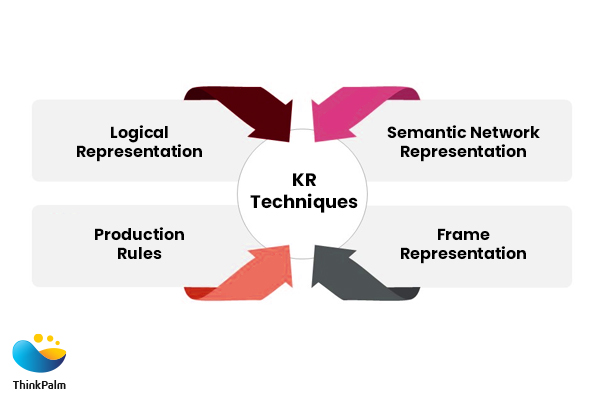We all are familiar with the word “Knowledge,” but have you heard of “Knowledge Representation” and “Knowledge Representation in AI”? Think like this: You’re trying to make a perfect basketball shot. Think about all the things your mind and body do to make it happen.
Now, imagine trying to teach the same to a machine. It’s a big challenge since you’ll need a vast amount of knowledge to present this to the machine. Even simple scenarios like lifting a pen off the desk will need a big set of rules and descriptions.
That’s where ‘Knowledge Representation in AI’ comes in – it’s the key to making all of this work. Here, knowledge representation plays a vital role in setting up the environment and gives all the details necessary to the system. It’s like a guiding light that unlocks the machine’s potential.
Let’s explore how AI uses “knowledge” to change how businesses operate, and I’ll make sure to keep you engaged till the end.
‘Knowledge representation in AI’ is like giving computers a smart brain. It’s the magic that allows them to understand and use real-world information to solve tricky problems.
In simple terms, it’s about teaching AI to think and reason using symbols and automation. For instance, if we want AI to diagnose illnesses, we must provide it with the right knowledge at the right time.
So, in a nutshell, it’s all about making computers brilliant problem solvers by communicating in their unique “language” of information or a way that a computer system can understand and apply it to tackle real-world problems or manage everyday tasks.
Knowledge is like the wisdom a computer gathers from its experiences and learning. Imagine it as the “know-how” that makes an AI (like a chatbot) savvy. In Artificial Intelligence, a machine takes specific actions based on what it has learned in the past. For example, think of an AI winning a chess game—it can only do that if it knows how to play and win.
Representation is how computers translate their knowledge into something useful. It’s like turning knowledge into a language computers understand. This includes things like:
In simple terms, knowledge is what we know from our experiences, facts, data, and situations. In artificial intelligence, there are various types of knowledge that need to be represented.
These types of knowledge equip AI to understand and solve problems, follow instructions, make informed decisions, and adapt to different situations.
In the world of artificial intelligence, we use various methods to express what AI knows. The choice depends on how information is organized, what the designer thinks, and how the AI system works. Therefore, good knowledge representation should be clear, practical, and easy to handle. Here are four main knowledge representation techniques used in AI:
In AI, we communicate using formal logic, much like following a rulebook. Imagine AI as a student following a strict set of rules in a school. These rules ensure that information is shared with minimal mistakes and that AI’s conclusions are either true or false. Though it can be tricky, logical representation is like the foundation of many programming languages, helping AI think logically.
Think of a semantic network as a giant web with connected nodes and links. Nodes stand for objects or ideas, while links show how they connect. This method simplifies how AI stores and arranges information, much like a mind map. It’s more natural and expressive compared to logical representation, allowing AI to grasp complex relationships.
Frames act like information ID cards for real-world things. They contain details and values describing these things. Imagine each frame as a file containing important information. Frames can be flexible and, when connected, create a robust knowledge system. This method is versatile and commonly used in AI.
Imagine AI using “if-then” statements to decide what to do. If a specific situation arises, AI knows exactly what action to take. This method is like having a playbook. Production rules are modular, making it easy to update and add new rules. While they may not always be the fastest, they let AI make smart choices and adapt to different scenarios.
These techniques give AI the tools it needs to organize and use knowledge effectively, making it smarter and more capable.
To make AI intelligent, we need a way to gather vital information. That’s where the AI knowledge cycle and its essential components come into play. These components help AI understand the world better and make intelligent choices. It’s like giving AI the tools to learn, adapt, and act wisely.
A good knowledge representation system should have these qualities:
Knowledge representation gives AI the power to handle complex tasks based on what it has learned from human experiences, rules, and responses. It’s like the AI’s “instruction manual” that it can read and follow.
Moreover, AI relies on this knowledge to solve problems, complete tasks, and make decisions. It helps AI understand, communicate in human language, plan, and tackle challenging areas. Therefore, it’s the backbone of AI technology all around us.
What is the significance of knowledge representation in AI?
Knowledge representation in AI is like the way our brain stores and organizes information, helping AI systems think and make decisions more like humans do.
What are the 4 types of knowledge representation?
There are four main approaches to knowledge representation in AI: relational, inheritable, inferential, and procedural.
Why is knowledge representation important?
Knowledge representation is important in AI because it allows computers to understand, store, and manipulate human knowledge, enabling them to solve complex problems, make decisions, and perform tasks that require intelligence.
What are the objectives of knowledge representation?
Knowledge representation’s goal is to show relationships between ideas and objects so we can draw conclusions and make inferences easily.
At ThinkPalm, we specialize in AI development services, with a specific emphasis on effective knowledge representation for intelligent AI systems. Moreover, our experienced team collaborates closely with you to elevate your AI applications, ensuring they are not just capable but also at the forefront of technology. Whether you’re venturing into AI software development, exploring the business advantages of AI, or modernizing your technology stack, ThinkPalm’s dedicated AI development services are here to assist you. Connect with our AI experts today!